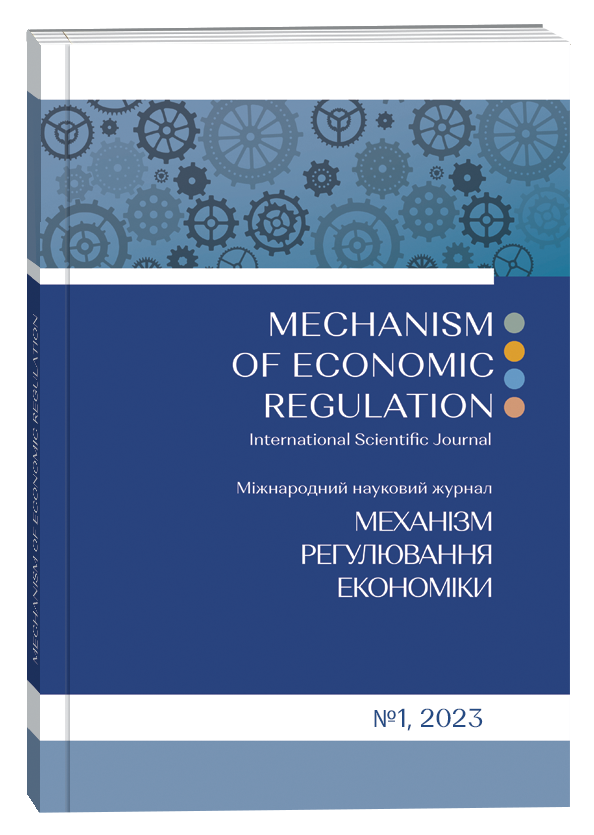INSTRUMENTS FOR ENSURING THE PHASE TRANSITION OF ECONOMIC SYSTEMS TO MANAGEMENT BASED ON INDUSTRIES 3.0, 4.0, 5.0
Abstract
The article develops the concept of key categories related to the phase transition to a new socio-economic formation: industrial revolutions Industries 3.0, 4.0, 5.0; the transition implementation mechanism; transformational processes; trialectic mechanisms of system formation. The key features of the economic system, which can be formed through a phase transition, are conditionally characterized. In particular, such an economy can be called a sustainable economy because it ensures the achievement of sustainable development goals. The essence of modern industrial revolutions (Industries 3.0, 4.0, 5.0) is revealed through which the specified phase transition is realized. In particular, Industries 5.0 is a phenomenon of human adaptation to a cybergized environment, during which the personal basis of a person develops, in particular, based on the synergistic integration of human cognitive abilities and artificial intelligence, as well as human biological nature and technical means. Based on a trialectic view of the system-forming factors of the beginning (material, informational and synergistic), the key groups of instruments for ensuring the specified phase transition were characterized, in particular, the group of instruments that provide the material prerequisites for the implementation of the phase transition can include: the introduction of alternative energy; large-scale energy accumulation; implementation of additive technologies (3D printing); formation of cyber-physical systems; implementation of the Internet of Things; miniaturization of economic assets. In the group of information prerequisites, the following instruments can be listed: mass computerization; sensory revolution; dematerialization of economic systems; the formation of the cloud as a global memory system and a global control centre; mass adoption of RFID tags. The group for ensuring synergistic prerequisites consists of globalization of Internet communications; creation of EnerNet (unified information and energy systems); creation of a global GPS; transition to network economic systems; formation of virtual enterprises.
References
Melnyk, L. (2021). Socio-natural antientropic potential: The role of economy and innovations. Environment, Development and Sustainability, 23(3), 3520-3542. DOI: https://orcid.org/10.1007/s10668-020-00730-0
Industry 4.0. (n.d.) Wikipedia. URL: http://en.m.wikipedia.org/wiki/Industry_4.0
Shahan, Z. (2016). 10 Solar Energy Facts & Charts You (& Everyone) Should Know. Clean Technica. URL: https://cleantechnica.com/2016/08/17/10-solar-energy-facts-charts-everyone-know
Evans, D. (2011). The Internet of Things. How the Next Evolution of the Internet is Changing Everything. Cisco IBSG. URL: http://www.cisco.com/web/about/ac79/docs/innov/IoT_IBSG_0411FINAL.pdf
Horx, M. (2020). The Power of the Megatrends. About the turbulence of the future. Zukunftsinstitut Horx GmbH. URL: https://www.horx.com/en/speeches/the-power-of-the-megatrends
O’Neill, R. (2008). 3D Self-Replicating Printer to be Released Under GNU License. SlashdotMedia. URL: https://hardware.slashdot.org/story/08/04/07/210205/3d-self-replicating-printer-to-be-released-under-gnu-license
Rada, M. (2017). Industry 5.0 definition. Linked in. URL: https://www.linkedin.com/pulse/industrial-upcycling-definition-michael-rada
Rifkin, J. (2013). The Third Industrial Revolution: How Lateral Power is Transforming Energy. The Economy, and The World. New York: St. Martin׳s Griffin Publisher.
Rifkin, J. (2015). Zero Marginal Cost Society: The Internet of Things, the Collaborative Commons, and the Eclipse of Capitalism. New York: St. Martin׳s Griffin Publisher.
Rossi, B. (2018). What will Industry 5.0 mean for manufacturing? Raconteur. URL: https://www.raconteur.net/technology/manufacturing-gets-personal-industry-5-0
Schwab, K. & Davis, N. (2018). Shaping the Fourth Industrial Revolution. Cologny, Switzerland: Would economic Forum, Commited to Improving the State of the World.
Skinner, C. (2018). Digital Human. – Marshall Cavendish International (Asia) Pte Ltd.
Vollmer, M. (2018). What is Industry 5.0? Linked in. URL: https://www.linkedin.com/pulse/what-industry-50-dr-marcell-vollmer
Zennaro, M. (2017). Introduction to the Internet of things. NBTC–ITU Training on «Building IoT solutions for e-applications». URL: https://www.itu.int/en/ITU-D/Regional-Presence/AsiaPacific/SiteAssets/Pages/Events/2017/Nov_IOT/NBTC%E2%80%93ITU-IoT/Session%201%20IntroIoTMZ-new%20template.pdf
Melnyk, L., Matsenko, O., Kubatko, O., Korneyev, M., & Tulyakov, O. (2022). Additive economy and new horizons of innovative business development. Problems and Perspectives in Management, 20(2), 175-185. DOI: https://orcid.org/10.21511/ppm.20(2).2022.15


